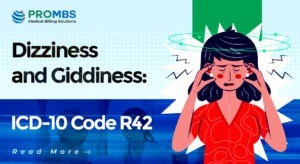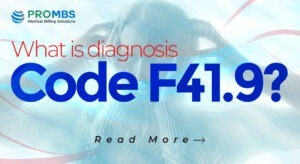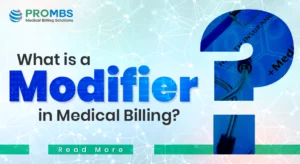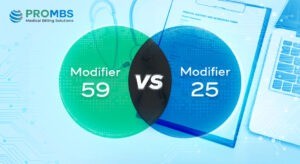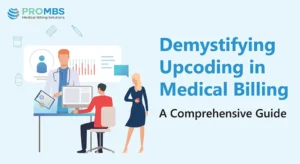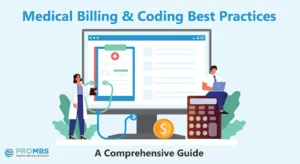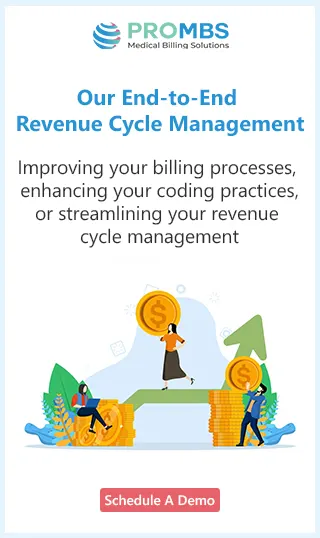There is a famous proverb saying “If it isn’t coded then it hasn’t been done”. The same applies to medical billing professionals, while using the modifiers because the correct use of modifiers is essential for accurate billing, successful reimbursement, and denial avoidance.
In the systematic but complex world of medical billing and coding, understanding the rules of modifiers plays an important role in accurate billing, reimbursement, and compliance. Precise documentation and accurate coding play a pivotal role in compliance with regulations. The understanding of medical bills depends upon details. It is all about the difference between smooth payments and monetary hassles. These modifiers are important for guaranteeing the accuracy of medical invoices to ensure proper compensation for healthcare providers.
Among various modifiers used for medical billing two most commonly used modifiers are Modifier 59 and Modifier 25. These two modifiers serve different and distinctive purposes but can be confusing sometimes. In this blog, we will dig into the difference between Modifier 59 and Modifier 25, their respective roles, functions, key considerations, and respective distinctions for healthcare providers and medical billing professionals.
What is Modifier 59:
Modifier 59 is used to identify the procedures or services that are unique and distinct from other services performed on the same day. By using Modifier 59 a user can specify the services performed which are distinct from other services executed in a session. It can even separate the distinct services provided to the same encounter by the same or different healthcare providers. A provider would prefer to use this modifier to easily distinguish and validate a pair of codes that can’t be billed together. The main purpose of Modifier59 is that services billed are not bundled together under standard coding rules
According to the CPT document, except for Evaluation and Management (E/M) services Modifier 59 is frequently used in medical billing to specify the services and procedures that are not billed or reported together related to the situations. The documentation of these services must support a distinct session of all the procedures which does not normally happen by the same individual on the same day.
Modifier 59 should only be used for a procedure when no other modifier fulfills the association between two codes of the procedure. In case, another modifier is more relevant and can clearly explain the billed service Modifier 59 should be avoided
When to use Modifier 59
1. Distinct Services:
In a case when two or more services are performed during the same encounter with the patient but services are separate and independent from each other, the modifier 59 is used to indicate the distinction of procedure or service.
2. Different Session
If service is performed during separate encounters on the same day, Modifier 59 is used to distinguish each encounter.
3. Different Anatomical Sites
If different anatomical sites are used for procedures, Modifier 59 is used to differentiate that these services are not part of the same treatment.
Proper supporting documents and explanations must be maintained for Modifier 59 application otherwise misuse of Modifier 59 may lead to strict scrutiny from payers and auditors.
Modifier 25:
If we talk about the Modifier 25 it applied to the Evaluation and Management Services to signify that distinct and distinguishable E/M service has been provided as another procedure or service on the same day. According to the CPR-4 Manual, a modifier 25 service is used for separately recognizable Evaluation and Management Services performed by the same physician either on the same day of the procedure performed or for some other service. If a patient’s condition requires an independent E/M service beyond the scope of other procedures on the same day another service is performed Modifier 25 is used.
When to use Modifier 25
Distinct E/M Service:
In case a separate E/M Service such as the visit of a patient or consultation is provided alongside a procedure Modifier 25 is used. If the E/M service provided is separately identifiable and necessary it would be attached to the E/M code.
Medically Necessary:
The E/M service provided must be recognized as medically necessary and shouldn’t simply be related to the general procedure performed. The supporting documentation must show its distinct nature and also must be justifiable for billing separately.
Compliance with Coding Guidelines
Compliance with the coding guidelines is necessary for the usage of Modifier 25. In case when both procedure and E/M service are rendered during the same encounter compliance with coding guidelines are crucial.
Some Key Facts
According to Outsource Strategies International there are reports that many of the bills filed through modifiers were denied. Many of the denied claims were submitted through Modifiers 59 and 25. The reasons for the denials were inappropriate or higher than average usage of these modifiers. The Illinois Chiropractic Society (ICS) strongly advises to
- Demonstrate a valid use of modifier for appeal of specific denials
- Appeal the denial by mentioning related supporting documentation to justify the medical necessity
- Adhere to the coding guidelines to avoid reimbursement hassles and denials.
Key Differences
Modifier 59 is for distinct procedures and services to highlight that those services are separate and independent from each other while Modifier 25 is specific to the Evaluation and Management (E/M) Services indicating that a specific E/M service is provided in addition to another service.
For accurate reimbursement of distinct procedures or services Modifier 59 is used to unbundle the procedures that are usually bundled together, however, the application of the Modifier 25 is to identify the E/M service and distinguish it from other procedures performed during the same session.
The supporting documentation for Modifier 59 must indicate the distinctiveness of each procedure. The unbundling of the procedure must be justified. Modifier 25 requires clear document evidence to rationalize the necessity of separate E/M services performed. The documentation is provided to illustrate the separate E/M service in the overall service provided.
Best Practices for Usage
Healthcare providers should document each service provided with specificity, highlighting the distinct nature of procedures or E/M services. The proper documentary support is essential for each of the modifiers to follow the coding guidelines and procedures.
To avoid claim denials and audit difficulties the coders and billers must be familiar with the latest guidelines, updates, and payer policies. The billing companies should arrange regular periodic training on the updates and regulatory changes. These trainings are essential for accuracy in the billing practices.
For accurate billing practices proper communication between coders, healthcare providers, and billers is imperative. Along with communication, the collaborative efforts reduce the error factor, and all the services and procedures are appropriately coded, billed, and reimbursed.
In a nutshell, each of Modifiers 59 and 25 serves distinct purposes in medical billing and coding. Each modifier is for a different situation. The coders and billers must first understand the nature of the situation and procedures they are coding for. Understanding and adhering to the coding guidelines minimize the error factor. Proper documentation is important to justify each case. Proper communication and collaboration among stakeholders and healthcare providers lead to trust, revenue integrity, and quality patient care.




